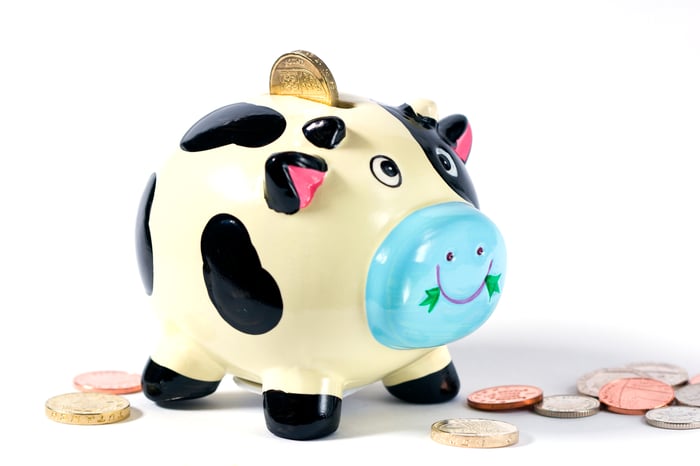The S&P 500 Index is offering a pitiful yield of just 1.3%, which makes the 6.6% yield on offer from Kinder Morgan (KMI -0.30%) look incredibly appealing. And the truth is, relatively speaking, it is. But there's no such thing as a perfect investment, so here's a look at the bull case for Kinder Morgan and the bear case.
Why Kinder Morgan is great
Kinder Morgan's yield is five times larger than that of the S&P 500 Index. For dividend-focused investors, that's an awfully powerful draw. Better yet, it has been increasing its dividend annually since 2018, including a hike in pandemic hit 2020. The energy sector experienced a deep downturn that year as economic closures led to a quick drop in energy demand, and a number of very large names in the broader energy sector, like BP and Shell, cut their dividends to save cash. So Kinder Morgan's commitment to shareholders despite the headwinds of the coronavirus is a pretty big positive.

Image source: Getty Images.
Part of the reason it was able to make this call is that its distributable cash flow covers its distribution strongly. In the third quarter of 2021 coverage was a huge 1.6 times. That leaves a great deal of room for adversity before the dividend would be at risk of a cut.
ESG-inclined investors might argue that Kinder Morgan is tied to the carbon fuel economy, but that's not as big an issue as you may think. For starters, the bulk of its business is fee-based, so demand for energy is the key factor, not the price of energy. Kinder just collects tolls on the products moving through its massive, and likely irreplaceable, North American midstream energy system. Notably, global demand for energy is still increasing thanks to developing markets, which will likely mean absolute demand for oil and natural gas grows even as their share of the total energy picture shrinks. But as long as demand is there, Kinder Morgan can collect its tolls and keep throwing off ample amounts of cash to investors.
There's a lot to like here if you can step back and think outside the box.
Why Kinder Morgan might still be trouble
Another positive about Kinder Morgan is that its balance sheet has improved materially over the past few years. Indeed, financial debt to earnings before interest, taxes, depreciation, and amortization (EBITDA) has fallen from over 9 times in 2016 to around 5 times today. But this is the negatives section, and the bigger takeaway here is that this is higher than more conservative peers like Enterprise Products Partners (EPD 0.22%) and Magellan Midstream Partners (MMP), which come in at 3.9 times and 3.6 times, respectively. So Kinder Morgan's balance sheet is better than it was, but not the best in the midstream sector.
KMI Financial Debt to EBITDA (TTM) data by YCharts
This is important because the sector is facing a challenging growth environment. Historically, building from the ground up was the primary way midstream companies expanded. But given the clean energy zeitgeist, that path is greatly diminished. It's likely that acquisitions will take a more prominent role in the future. Kinder Morgan is large and diversified enough to be a consolidator, but given its elevated leverage there's a risk that it could end up overextending itself if it gets too aggressive.
That line of reasoning brings the story back to 2016, when leverage was extremely high. In late 2015 Kinder Morgan's management team told investors to expect a dividend hike of as much as 10% in 2016, only to turn around and cut the dividend by 75% just a couple of months later. An over-leveraged balance sheet was a key reason for the move, which destroyed the trust of some investors. In fact, the dividend still isn't back to its pre-cut level.
If you are a conservative investor and trust is an important issue for you, Kinder Morgan probably hasn't done enough yet to work back from the hit of that cut just yet. That's not to suggest that Kinder Morgan is poorly run, only that it is operating in a difficult market that's dealing with structural changes -- and the history here suggests that a dividend cut is something to fear during uncertain times, even though the payout looks to be well backed today.
As for that clean energy transition, Kinder Morgan has only just started to address it, and only at the margins. Some of its peers, notably Enbridge, have been much more aggressive on this front. That's another reason you might consider alternative investments in the midstream space.
Is the yield high enough?
There's plenty of reason to like Kinder Morgan and its fat 6.6%, well covered dividend yield. If you are a glass-half-full type of investor, you might be tempted to jump aboard. And that's not unreasonable at all -- Kinder Morgan is a large and generally well-run midstream company. However, the 2016 dividend cut exposed some risks here that haven't really gone away. They've gotten better, for sure -- note the improved balance sheet strength -- but there are other large midstream options with similarly high yields and way better dividend track records. Conservative types with a glass-half-empty view of things would probably be better off elsewhere.






